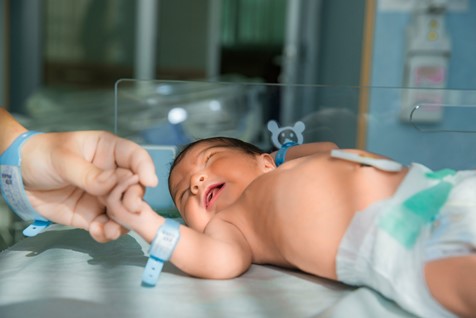
Researchers review advancements in biosensing technologies that can address the limitations of conventional diagnostic methods for neonatal sepsis
Sepsis in newborn infants can be fatal. Early diagnosis is thus key to effectively managing the infection. Conventional diagnostic methods are, however, time-consuming. Now researchers from Shoolini University, in collaboration with IIT Hyderabad and Amity University, Rajasthan, describe the current point-of-care methods for improved diagnosis of neonatal sepsis and their limitations. Their review sheds light on emerging biosensors that can revolutionize diagnostics in the future and help decrease mortality associated with neonatal sepsis.
Sepsis refers to a systemic (body-wide) infection accompanied by inflammation. Newborn infants are particularly susceptible to developing sepsis, given their na?ve and underdeveloped immune systems. Their immune system reacts to the acquired pathogen by releasing inflammatory factors such as cytokines and free radicals. The heightened immune response mounted against the pathogen if uncontrolled, can cause severe damage to other organs, which can be fatal for the newborn. The prevalence of neonatal sepsis and associated mortality rates are especially high in developing countries, owing to poor sanitation and the dearth of healthcare resources.
Early diagnosis is thus cardinal for effective management of the infection and decrease neonatal mortality. Current point-of-care (POC) methods rely on conventional blood culture and molecular techniques that may be time-consuming and often detect a single parameter or biomarker. Hence, the development of rapid, sensitive, and integrated diagnostic strategies is crucial to enhance detection and improve the standard of care.
In a new Clinica Chimica Acta article, researchers from Shoolini University, in collaboration with researchers from IIT Hyderabad and Amity University, Rajasthan, India, have reviewed the latest advancements in analytical devices that enable multi-analyte detection with high sensitivity and accuracy. They also describe the limitations of currently used methods and why a combinatorial approach may be better. Speaking of why this caught their attention, the lead author of the study, Dr. Anupam Jyoti, says, Developing countries like India report an increased incidence of neonatal sepsis (5070/1000 live births) as compared to developed countries (15/1000 live births), with a substantial mortality rate of 11-19%. We were thus motivated to review the field of neonatal sepsis detection and propose new directions towards effective diagnosis.
Routinely used blood culture techniques often require two to five days to yield results. Meanwhile, the infection escalates, and the newborn is often pumped with unnecessary antibiotics that can lead to anti-microbial resistance. Techniques such as the polymerase chain reaction, which detects the genetic material of the pathogen, and mass spectrometry, which detects pathogen-specific proteins, are more sensitive and require less time. However, they can yield false-positive results and do not differentiate between viable and non-viable pathogens in the sample. While tests that detect serum biomarkers and immune factors, expressed in response to infection, may give a broad idea about the presence of sepsis, they cannot differentiate between specific pathogens. Together, the methods may however complement each other for robust diagnosis of sepsis.
Biosensing analytical technologies have emerged as a powerful tool in biomedical devices. Advanced biosensors that promise multi-analyte detection in a single platform are now being increasingly developed for rapid and sensitive diagnosis. Electrochemical sensors can detect various electrolytes and biomarkers based on their specific electrical properties. Aptamers or single-stranded nucleic acid probes, given their minute size, stability, and high binding affinity, are useful for detecting bacterial traces in the blood. Next, sensors based on the surface plasmon resonance technique can detect changes in the optical properties of the sample. They are highly sensitive with low limits of detection, thus enabling the detection of small concentrations of pathogens. Finally, microfluidic devices and chip-based sensors analyze samples based on their flow or size and can thus detect bacterial and blood cells in the samples of patients with sepsis.
In addition to the above methods, integrated approaches that combine the principles of multiple techniques on a single platform are gaining popularity. Such hybrid biosensors will be capable of detecting multiple parameters in a short time from considerably small samples; all this at the bedside of the patient! Moreover, their wide applicability, cost-effectiveness, small size, and need for limited resources make them a practical and valuable tool for the diagnosis of neonatal sepsis.
Overall, the review sheds light on modern technologies that can help strengthen, and possibly replace conventional POC approaches in the future. Integrated POC based diagnosis will help reduce detection time considerably and thus translate diagnosis from bench to the bedside. An efficient POC sepsis diagnostic platform could expand health care access and impact populations worldwide. remarks an excited Dr. Jyoti.
This is indeed a ray of hope for protecting neonatal health.
Reference
| Authors | Anupam Jyoti a,c,1,*, Sanni Kumar b,1, Vijay Kumar Srivastava a, Sanket Kaushik a, Shiv Govind Singh b * |
| Title of the original paper | Neonatal sepsis at point of care |
| Journal | Clinica Chimica Acta |
| DOI | https://doi.org/10.1016/j.cca.2021.06.021 |
| Affiliations | a. Amity Institute of Biotechnology, Amity University, Rajasthan India b. Department of Electrical Engineering, Indian Institute of Technology, Hyderabad, India c. Faculty of Applied Sciences and Biotechnology, Shoolini University of Biotechnology and Management Sciences, Himachal Pradesh, India |
Single platform and multi-analyte detection strategies using biosensors can improve the diagnosis of infections in newborn infants
About Associate Professor, Dr. Anupam Jyoti
Dr. Anupam Jyoti has completed his PhD from the CSIR-Central Drug Research Institute, Lucknow, India. He is currently an Associate Professor at the School of Biotechnology, Faculty of Applied Sciences and Biotechnology Shoolini University, Himachal Pradesh, India. His research interests include sepsis and associated immune responses, antibiotics, and infections. He has authored several publications in these areas.